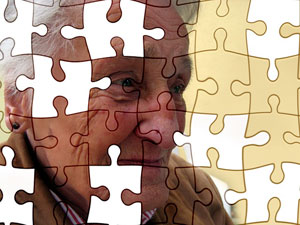Dementia
This article uses material from the Wikipedia article “Dementia”, which is released under the Creative Commons Attribution-Share-Alike License 3.0.
Dementia, also known as senility,[1] is a broad category of brain diseases that cause a long term and often gradual decrease in the ability to think and remember that is great enough to affect a person’s daily functioning.[2] Other common symptoms include emotional problems, problems with language, and a decrease in motivation.[2][3] A person’s consciousness is not affected.[2] A dementia diagnosis requires a change from a person’s usual mental functioning and a greater decline than one would expect due to aging.[2][4] These diseases also have a significant effect on a person’s caregivers.[2]
 The most common type of dementia is Alzheimer’s disease, which makes up 50% to 70% of cases. Other common types include vascular dementia (25%), (15%), and frontotemporal dementia.[2][3] Less common causes include normal pressure hydrocephalus, Parkinson’s disease, syphilis, and Creutzfeldt–Jakob disease among others.[5] More than one type of dementia may exist in the same person.[2] A small proportion of cases run in families.[6] In the DSM-5, dementia was reclassified as a neurocognitive disorder, with various degrees of severity.[7] Diagnosis is usually based on history of the illness and cognitive testing with medical imaging and blood work used to rule out other possible causes.[8] The mini mental state examination is one commonly used cognitive test.[3] Efforts to prevent dementia include trying to decrease risk factors such as high blood pressure, smoking, diabetes, and obesity.[2] Screening the general population for the disease is not recommended.[9]
The most common type of dementia is Alzheimer’s disease, which makes up 50% to 70% of cases. Other common types include vascular dementia (25%), (15%), and frontotemporal dementia.[2][3] Less common causes include normal pressure hydrocephalus, Parkinson’s disease, syphilis, and Creutzfeldt–Jakob disease among others.[5] More than one type of dementia may exist in the same person.[2] A small proportion of cases run in families.[6] In the DSM-5, dementia was reclassified as a neurocognitive disorder, with various degrees of severity.[7] Diagnosis is usually based on history of the illness and cognitive testing with medical imaging and blood work used to rule out other possible causes.[8] The mini mental state examination is one commonly used cognitive test.[3] Efforts to prevent dementia include trying to decrease risk factors such as high blood pressure, smoking, diabetes, and obesity.[2] Screening the general population for the disease is not recommended.[9]
There is no cure for dementia.[2] Cholinesterase inhibitors such as donepezil are often used and may be beneficial in mild to moderate disease. [10][11][12] Overall benefit, however, may be minor.[12][13] For people with dementia and those who care for them many measures can improve their lives.[2] Cognitive and behavioral interventions may be appropriate.[2] Educating and providing emotional support to the caregiver is important.[2] Exercise programs are beneficial with respect to activities of daily living and potentially improve outcomes.[14] Treatment of behavioral problems or psychosis due to dementia with antipsychotics is common but not usually recommended due to there often being little benefit and an increased risk of death.[15][16]
 Globally, dementia affects 36 million people.[2] About 10% of people develop the disease at some point in their lives.[6] It becomes more common with age.[17] About 3% of people between the ages of 65–74 have dementia, 19% between 75 and 84 and nearly half of those over 85 years of age. [18] In 2013 dementia resulted in about 1.7 million deaths up from 0.8 million in 1990.[19] As more people are living longer, dementia is becoming more common in the population as a whole.[17] For people of a specific age, however, it may be becoming less frequent, at least in the developed world, due to a decrease in risk factors.[17] It is one of the most common causes of disability among the old.[3] It is believed to result in economic costs of 604 billion USD a year.[2] People with dementia are often physically or chemically restrained to a greater degree than necessary, raising issues of human rights.[2] Social stigma against those affected is common.[3]
Globally, dementia affects 36 million people.[2] About 10% of people develop the disease at some point in their lives.[6] It becomes more common with age.[17] About 3% of people between the ages of 65–74 have dementia, 19% between 75 and 84 and nearly half of those over 85 years of age. [18] In 2013 dementia resulted in about 1.7 million deaths up from 0.8 million in 1990.[19] As more people are living longer, dementia is becoming more common in the population as a whole.[17] For people of a specific age, however, it may be becoming less frequent, at least in the developed world, due to a decrease in risk factors.[17] It is one of the most common causes of disability among the old.[3] It is believed to result in economic costs of 604 billion USD a year.[2] People with dementia are often physically or chemically restrained to a greater degree than necessary, raising issues of human rights.[2] Social stigma against those affected is common.[3]
Signs and symptoms
The symptoms of dementia vary across types and stages of the diagnosis.[20] The most common affected areas include memory, visual-spatial, language, attention and problem solving. Most types of dementia are slow and progressive. By the time the person shows signs of the disease, the process in the brain has been happening for a long time. It is possible for a patient to have two types of dementia at the same time. About 10% of people with dementia have what is known as mixed dementia, which is usually a combination of Alzheimer’s disease and another type of dementia such as frontotemporal dementia or vascular dementia.[21][22] Additional psychological and behavioral problems that often affect people who have dementia include:
Balance problems
Tremor
Speech and language difficulty
Trouble eating or swallowing
Memory distortions (believing that a memory has already happened when it has not, thinking an old memory is a new one, combining two memories,
or confusing the people in a memory)
Wandering or restlessness
Perception and visual problems[23]
Behavioral and psychological symptoms of dementia (BPSD) almost always occur in all types of dementia. BPSDs may manifest as:[24]
Agitation
Depression
Anxiety
Abnormal motor behavior
Elated mood
Irritability
Apathy
Disinhibition and impulsivity
Delusions (often believing people are stealing from them) or hallucinations
Changes in sleep or appetite.
When people with dementia are put in circumstances beyond their abilities, there may be a sudden change to crying or anger (a “catastrophic reaction”).[25]
Depression affects 20–30% of people who have dementia, and about 20% have anxiety.[26] Psychosis (often delusions of persecution) and agitation/aggression also often accompany dementia. Each of these must be assessed and treated independently of the underlying dementia.[27]
READ MORE about dementia from WIKIPEDIA
References
1. “Dementia”. MedlinePlus. U.S. National Library of Medicine. 14 May 2015. Retrieved 27 May 2015. Dementia Also called: Senility.
2. “Dementia Fact sheet N°362”. who.int. April 2012. Retrieved 28 November 2014.
3. Burns, A; Iliffe, S (5 February 2009). “Dementia.”. BMJ (Clinical research ed.) 338: b75. doi:10.1136/bmj.b75. PMID 19196746.
4. Solomon, Andrew E. Budson, Paul R. (2011). Memory loss : a practical guide for clinicians. [Edinburgh?]: Elsevier Saunders. ISBN 9781416035978.
5. Gauthier, Serge (2006). Clinical diagnosis and management of Alzheimer’s disease (3rd ed.). Abingdon, Oxon: Informa Healthcare. pp. 53–54. ISBN 9780203931714.
6. Loy, CT; Schofield, PR; Turner, AM; Kwok, JB (1 March 2014). “Genetics of dementia.”. Lancet 383 (9919): 828–40. doi:10.1016/s0140-736(13)
60630-3. PMID 23927914.
7. Association, American Psychiatric (2013). Diagnostic and statistical manual of mental disorders : DSM-5. (5th ed.). Washington, D.C.: American Psychiatric Association. pp. 591–603. ISBN 9780890425541.
8. “Dementia diagnosis and assessment” (PDF). pathways.nice.org.uk. Retrieved 30 November 2014.
9. “Dementia overview” (PDF). https://pathways.nice.org.uk/. Retrieved 30 November 2014.
10. Birks, J (25 January 2006). “Cholinesterase inhibitors for Alzheimer’s disease.”. The Cochrane database of systematic reviews (1): CD005593. doi:10.1002/14651858.CD005593. PMID 16437532.
11. Rolinski, M; Fox, C; Maidment, I; McShane, R (14 March 2012). “Cholinesterase inhibitors for dementia with Lewy bodies, Parkinson’s disease
dementia and cognitive impairment in Parkinson’s disease.”. The Cochrane database of systematic reviews 3: CD006504. doi:10.1002/14651858.CD006504.pub2. PMID 22419314.
12. Kavirajan, H; Schneider, LS (September 2007). “Efficacy and adverse effects of cholinesterase inhibitors and memantine in vascular dementia:
a meta-analysis of randomised controlled trials.”. The Lancet. Neurology 6 (9): 782–92. doi:10.1016/s1474-4422(07)70195-3. PMID 7689146.
13. Commission de la transparence (June 2012). “Médicaments de la maladie d’Alzheimer : à éviter” [Drugs for Alzheimer’s disease: best avoided. No therapeutic advantage]. Prescrire Int 21 (128): 150. PMID 22822592.
14. Forbes, D.; Thiessen, E.J.; Blake, C.M.; Forbes, S.C.; Forbes, S. (4 December 2013). “Exercise programs for people with dementia.”. The
Cochrane database of systematic reviews 12: CD006489. doi:10.1002/14651858.CD006489.pub3. PMID 24302466.
15. National Institute for Health and Clinical Excellence. “Low-dose antipsychotics in people with dementia”. nice.org.uk. Retrieved 29 November 2014.
16. “Information for Healthcare Professionals: Conventional Antipsychotics”. fda.gov. 2008-06-16. Retrieved 29 November 2014.
17. Larson, EB; Yaffe, K; Langa, KM (12 December 2013). “New insights into the dementia epidemic.”. The New England Journal of Medicine 369
(24): 2275–7. doi:10.1056/nejmp1311405. PMID 24283198.
18. Umphred, Darcy (2012). Neurological rehabilitation (6th ed.). St. Louis, Mo.: Elsevier Mosby. p. 838. ISBN 9780323075862.
19. GBD 2013 Mortality and Causes of Death, Collaborators (17 December 2014). “Global, regional, and national age-sex specific all-cause and
cause-specific mortality for 240 causes of death, 1990-2013: a systematic analysis for the Global Burden of Disease Study 2013.”. Lancet 385
(9963): 117–71. doi:10.1016/S0140-6736(14)61682-2. PMC 4340604. PMID 25530442.
20. “Dementia”. American Speech Language Hearing Association. Retrieved from https://www.asha.org/PRPSpecificTopic.aspx? folderid=8589935289§ion=Signs_and_Symptoms.
21. What is vascular dementia? Alzheimer’s Society.
22. Lee AY (2011). “Vascular dementia”. Chonnam Med J 47 (2): 66–71. doi:10.4068/cmj.2011.47.2.66. PMC 3214877. PMID 22111063.
23. “Sight, perception and hallucinations in dementia”. Alzheimer’s Society. October 2015. Retrieved 4 November 2015.
24. Cerejeira J, Lagarto L, Mukaetova-Ladinska EB (2012). “Behavioral and psychological symptoms of dementia”. Front Neurol 3: 73.
doi:10.3389/fneur.2012.00073. PMC 3345875. PMID 22586419.
25. Geddes, John; Gelder, Michael G.; Mayou, Richard (2005). Psychiatry. Oxford [Oxfordshire]: Oxford University Press. p. 141. ISBN 0-19-852863-9. OCLC 56348037.
26. Calleo J, Stanley M (2008). “Anxiety Disorders in Later Life Differentiated Diagnosis and Treatment Strategies”. Psychiatric Times 25 (8).
27. Shub, Denis; Kunik, Mark E (April 16, 2009). “Psychiatric Comorbidity in Persons With Dementia: Assessment and Treatment Strategies”. Psychiatric Times 26 (4).



